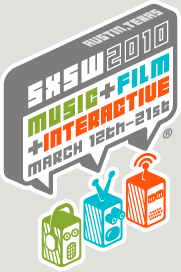***
Foldit — a massively multiplayer game/competition designed to reveal the shortcuts nature uses to weave a tangle of amino acids into a protein. Players use the cursor to grab, bend, pull, and wiggle the chain of amino acids anywhere along its length, folding the protein into its optimum shape. The only rules are based on physics — opposite charges attract, atomic bonds have limited angles of rotation, and the parts of the molecule that stick to water tend to point outward. The closer your model's properties adhere to those rules, the more points you get. Competing against the world's best biochemists in 2008's Community-Wide Experiment on the Critical Assessment of Techniques for Protein Structure Prediction (CASP), a band of gamer nonscientists who'd used Foldit won. [from Wired]
SETI@home — the screensaver that taps spare home computer cycles to sort through radio signals from space
Rosetta@home — farms out computation to volunteered PCs.
Star Wars Uncut — Star Wars A New Hope recreated by 450+ people.
Newgrounds — the large Flash games and animation site that spawned Alien Hominid, has been accepting user-produced submissions since 1999. Amy Bruckman and Kurt Luther are studying groups who make animations collaboratively on Newgrounds. They've found that the social organization of a collaborative project like this depends on the narrative structure of the animation. Making a more traditional story with a script written in advance has different constraints than a 'collection' where lots of pieces are assembled that can later be assembled in many orders by the project leader (for example, the animation 'When Farm Animals Attack'). Another mode is a 'continuation,' where each person adds to the end, and then passes it on to the next animator. These projects can be worked on by small to medium-sized groups (up to ~50 people). Star Wars Uncut is unusual in including nearly 500 people. Bruckman notes: "Part of what makes this kind of creative production different from an open source or wiki model is that an animation generally has *one release*. You don't show it publicly til you're done. Open source benefits from the 'release early, release often' model that lets more and more people contribute over time. Like open source software, these projects tend to have a central leader. There's a tremendous burden on that leader, and projects succeed or fail generally depending on how well the leader does his/her job, and how much time he/she can devote to the project."
Nick Carr says: "It's telling that, when we discuss this phenomenon, we still almost always trot out the same two examples that we would have trotted out five years ago: Wikipedia and open-source software. I think what we're discovering is that big online groups are very good at performing time-consuming, fairly routinized tasks that can be broken up into many discrete units of work and hence sped up by having lots of people with diverse talents and perspectives working on them in parallel without much coordination. Ferreting out bugs in a complex computer program and finding and paraphrasing information on discrete encyclopedia topics both, not surprisingly, fall into this category of work. But if you're looking for the new, the creative, the moment of blazing insight, you're still going to have to look not to a crowd but to an individual human mind."
Richard Hackman, social psychologist at Harvard who studies teams, notes in Leading Teams, that there are almost no forms of writing that benefit from collaboration (reference works, of course, being the notable exception.)
Nick Carr: "I think one of the reasons we're having trouble discussing the way brilliant new ideas emerge from "networked 'mass' groups" is because that phenomenon doesn't happen. The ideas for Wikipedia and Linux, to take, once again, the obvious examples, came from individuals, not from the groups that subsequently formed to bring the ideas to fruition. As Eric Raymond, the author of "The Cathedral and the Bazaar," once wrote in an email to me, "The individual wizard is where successful bazaar projects generally start." The Net can provide a powerful means of discovering the wizards (such as we saw in the competition for the Netflix Prize), and it can provide an effective means of coordinating and assembling the contributions of a "'mass' group," but the hope that great original concepts would naturally "emerge" from the interactions of a vast Net-connected group hasn't really panned out. I would argue that Internet crowds aren't all that interesting as a means of production (though, because they're often used as giant pools of free labor, they can certainly be economically disruptive in that role). What makes Internet crowds interesting is their social dynamics and the social forms that arise from those dynamics."














